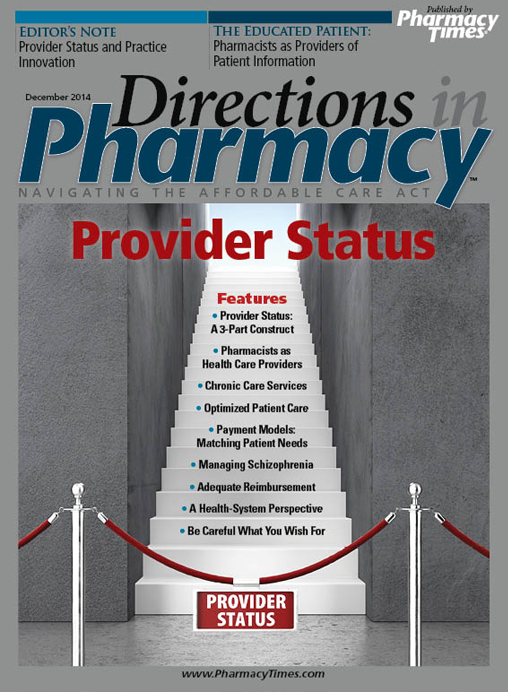Publication
Article
Pharmacy Practice in Focus: Oncology
Payment Models: Matching Patient Needs
Author(s):
As models for payment evolve, it's important to consider the best interests of the patient.

As models for payment evolve, it's important to consider the best interests of the patient.
As payment for pharmacist clinical services evolves, should we be advocating for a separate payment model or should we be advocating for our services to be a required component of team-based care payment models? Although our profession continues to grapple with this question, one statement that stirs far less controversy than the debate over payment is that pharmacists are the best-trained clinicians to ascertain if a patient’s drug therapy is appropriate. Pharmacists assess and manage issues related to medication adherence, medication reconciliation, drug therapy cost, appropriate drug dosing, potential adverse side effects, patient access to medications, drug—drug interactions, drug–disease interactions, drug therapy–related lab monitoring, inappropriate/ unnecessary drug therapy, patient education regarding medication administration, and drug therapy effectiveness, and oftentimes are responsible for drug therapy adjustment. Many believe it would be obscene to support a payment model that only addressed medication adherence without consideration of other aspects of drug therapy. Yet, just such a payment model has been gaining steam over the past year.
Payment for Medication Adherence
The Centers for Medicare & Medicaid Services’ (CMS’) 5-star rating program provides Medicare Part D health plans an opportunity to receive financial bonuses if they perform well on their score cards. If a health plan scores 4 or 5 stars, they receive a financial bonus from CMS. If they score fewer than 4 stars, they do not receive any financial bonus. This score card is composed of performance ratings on numerous measures, including medication adherence for diabetes mellitus, hypertension, and cholesterol medications. Across the country, in an effort to improve their medication adherence scores, these health plans have been contracting and paying pharmacists to focus on these 3 adherence measures. Payment for any pharmacist service is energizing; however, upon further reflection, does this payment model drive the best interests of the patient? If payment for adherence in the only end game, what happens in the case of a patient who is taking her cholesterol-lowering medication every other day, even though the prescription calls for a daily dose, and has a low-density lipoprotein cholesterol lab value that is at goal? Advising her to take this medication daily would likely be more costly, require liver function test monitoring, and could affect the metabolism of her other medications. It may also cause adverse events, such as myalgias, which are dose-dependent. Purely focusing on medication adherence, in this instance, could cause patient harm. Certainly, this is not the intent of CMS as the payer. This new payment model inadvertently has pharmacists focusing on one aspect of care, and not the patient.
Payment for Value
For better or worse, it is well understood that payment models influence the kind of care provided by clinicians. The Affordable Care Act uses this framework to improve patient care and reduce health care costs by driving payment for value versus payment for volume. In the patient case discussed above, the health plan is getting paid for achieving value, yet somehow the pharmacist is not.
We need to take a bold position and ensure that our payment is for value provided. We need to clearly establish that the most value a payer will get for pharmacist services comes from the pharmacist being paid to conduct a comprehensive visit to optimize medication use. It will not come from providing a narrow service. We also need to establish that value will be achieved when pharmacists have access to the patient’s medical record to review primary care provider progress notes, specialist provider notes, relevant lab tests, etc. In the patient case discussed above, the primary care provider may have noted that the patient has a history of myalgias associated with statins and stable mild hepatic impairment. Knowing this, the pharmacist would certainly not encourage medication adherence to the statin in question, but rather communicate their findings with the prescribing physician and develop a new treatment plan.
Integration to Achieve Value
Integration is the key to our value proposition. Efforts have been made over the years to demonstrate that integrating pharmacist services into care teams yields a positive return on investment. However, we have significant opportunities to be more effective and efficient in communicating with our care teams. Much work is needed to establish bidirectional electronic communication. Community pharmacy technology systems and health-system electronic medical record (EMR) systems must have the ability to transmit data in distinct clinical architecture, as faxing communications creates gaps in patient care. Such technology now exists. Our next step is to work with our pharmacy vendors to adopt the programming specifications and have them dialogue with local health-system EMR vendors so that health care professionals will be able to send patient progress notes, medication lists, immunization records, and lab results back and forth seamlessly.
Payment Model Reform
Provider status and payment reform go hand in hand. While it is important to pursue provider status, as it places pharmacists on a payer list to provide services, payment reform ensures that appropriate payment is made for these services. We have seen states in which pharmacists are recognized providers of their respective state Medicaid programs, but the payment for pharmacist services was set so low that it did not lead to a sustainable business model in which pharmacists would want to participate. Thus, while we pursue provider status, in parallel, we must consider sustainable payment models.
Payment model reform is underway, and each of us has a role to play. We must educate ourselves regarding evolving payment models of Medicare, Medicaid, self-insured employers, and local carriers. All of these payers are trying to figure out solutions to improve care and reduce costs. Never before has there been such a surge in the testing of care models and payment models. Desperation is the mother of invention. These are desperate times for payers, as their health care costs are rising year after year. If we are not at the table to define our role as pharmacists, it will be defined for us. We must educate payers regarding the value of pharmacist services. Each of us, in whatever capacity we can, should be involved in creating opportunities to be part of a pilot payment model with any payer. To get them to partner, consider accepting partial financial risk the first year to prove the value proposition.
To develop pharmacist payment models that meet patient needs, we need to consider a comprehensive service, secure access to patient medical records, develop efficient electronic communication with the entire care team, and take a seat at the innovation table.
Gloria Sachdev, PharmD, is clinical assistant professor at Purdue University College of Pharmacy and has an adjunct faculty position at Indiana University School of Medicine. She earned her PharmD at the University of Oklahoma.







